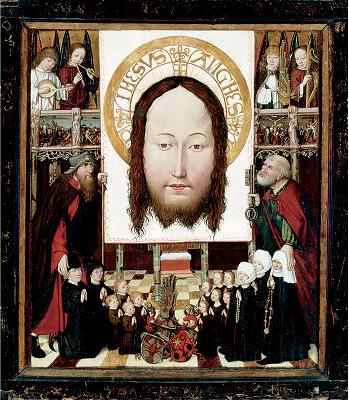| Anonynous (Austrian) A FAMILY GROUP ADORING THE VEIL OF
VERONICA
SN 304, oil on panel, c 1490
From "The Pages"
SUBJECT:
The day of the crucifixion, St Veronica pitied Christ on His way to Calvary and wiped the
blood from his face with her veil. Miraculously the imprint of his face and the crown of
thorns was transferred to the cloth, known a the vernicle. The relic has been preserved at
St Peter’s in Rome since the 8th c. Veronica’s attribute is the vernicle; she is
the patroness of linen drapers and washerwomen.
PAINTING:
This painting is characteristic of Austrian art. Although details indicate a date in the
late 1400s, in many respects it is late Gothic.
Saints Peter and James the Pilgrim are adapted from Flemish examples, but the short
figures and rounded faces of the family group are only a modest updating of types that had
been prevalent in Austria since the first quarter of the century. |
|
 |
Most astonishing is the almond-shaped face of Christ. Clearly a descendant of Byzantine
icons, it has hardly changed since 1400. The angels in the balcony, behind the carved
railing, play musical instruments to glorify God.
The family who commissioned the painting kneel beside St James. [He’s the one with
the shell and staff, next to the men of the family. St Peter appears on the right, next to
the female contingent. The family appears in smaller scale because they are less important
than the others there. In accordance with the rules of heraldry, the men are on the right
side and the women on the left, as shown in their shields. (They appear opposite as we
view the painting.)
Museum Label:
A Family Group Adoring the Veil of Veronica
c. 1490
Artist: Unknown
Austrian
Oil on panel, 31 1/2 x 27 in. (80 x 68.6 cm)
This panel painting depicts a family, flanked by their patron saints, Peter and Jacob, in
a church interior, venerating the Veil of Veronica, a cloth considered to show the first
true likeness of Christ. In the background an altarpiece with the Passion cycle is
visible, and the veil covers what is most likely a scene representing the Raising of the
Cross. The painting may have been commissioned to commemorate the death of the matriarch
of the family, of which the white cross in her hand is an indication.
Bequest of John Ringling, 1936, SN304
ringlingdocents.org
|